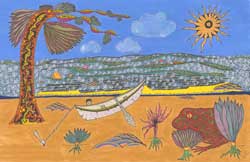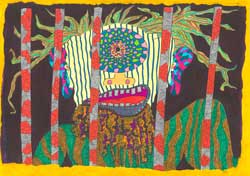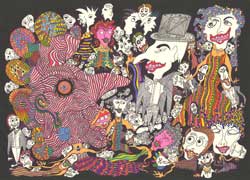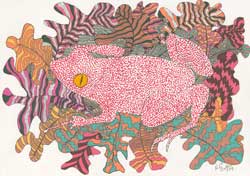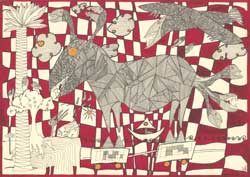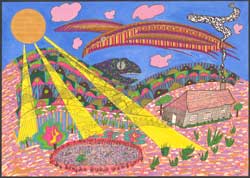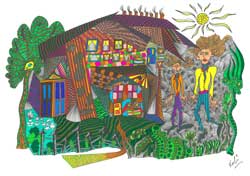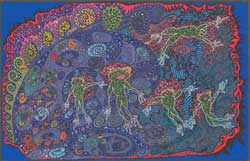Interview
You might want to read the novel first before reading the following.
In August 2015, my wife and I were teaching in Beijing. I’d returned from the summer vacation and was having a beer with an old friend. One thing led to another and before we knew it, we were discussing the possibility of an illustrated comic about frogs. The original idea was that the frogs turn into vampires, but once I got into that thread I realised that it’d been done over and over and the idea was bigger than a simple vampire story. So, from a quiet beer in a bar in Beijing came Wo-Sak, The Frog God.
As I said, the original idea grew from a chat in a bar. But the central ideas of reincarnation, rejuvenation and eternal life are things that have interested me all my life. I was brought up in a very religious household and so it’s kind of second nature to consider these things. It just fitted in with the original springboard idea of afterlife. And the idea of where we get religion from has always fascinated me. For example, which cave man thought of the very first child sacrifice, and why? Let’s face it, there had to be a first.
I’d already got some drawings which I thought might be useful and so considered how to develop ideas around those. From that I considered a hero who transcends time and geography. Before I knew it, I was writing a book. Many years ago I lived in South America and travelled up to Peru. I became fascinated by the Incas. Although this book is not about the Incas, they were instrumental in my original ideas of ancient civilizations and how they might impact today’s world.
I think there’s a connection between the idea in the book and the current belief systems in the world. All the great religions believe in one God and life after death. So it is with the ancients in my book. The fact that they sacrifice humans, and children in particular, has resonance today as there are examples of sacrifice in many religions. The interesting thing about Gamboa is how he confronts the conflict he faces when he realises that perhaps he has been doing the wrong thing all his life - and that he should change his ways. Also the ideas of myth, legend and truth come through very strongly and this is something I take very seriously.
Most definitely a hero. He is chosen as a child. He grows up to lead his nation. He transcends time and he takes a massive leap of faith.
Turning water into wine. Walking on water. Healing the blind. Raising the dead. Are these ideas any more fantastical? The very fact that most people believe in something they can’t see is, in my mind, far more fantastic than the central leap of faith in Wo-Sak,The Frog God. The book is what I call a plausible fantasy. Could it happen? Why not? The ancients believed in all kinds of gods, why not now? For all the science and technology we have at our fingertips, no one has, as yet, scientifically proven the existence of God and life after death. I think the leap of faith in the book is simply that - faith.
I think it’s a good read and good entertainment. If there’s a deeper, hidden message then fine. But I think its value lies in the fact that science can’t disprove any of it. And it is in main based on historical fact. These ancient peoples did sacrifice humans and they did kill children. I would like to think that it wouldn’t happen again. But, you have to remember that they did it in the name of religion. They actually believed in this!
I’m very happy with it and wouldn’t change anything. It’s a lifetime’s ambition of mine achieved, so that can’t be bad, can it?
Definitely. I am a firm believer in reading stories aloud to kids. And not only kids, adults too. I have read and re-read over and over again, the whole text out loud and created characters and drama just sitting on my own in my living room. As a teacher I spent a lifetime of work doing this kind of thing. Yes, my understanding of Drama definitely helped me write it.
No, I did not base him on anyone I know. Gamboa is a one-off. A magnificent creature, great physique, an athlete and extremely astute. No, I didn’t base him on anyone I know as I don’t know anyone with his qualities!
God the Father, God the Son and God the Holy Ghost. Easy.
Quite a bit, I suppose. For example, a lot of the geography of the novel I didn’t have to research too much as I know my world pretty well. Of course there are details requiring confirmation, but it was great to be able to write confidently knowing that it would make sense geographically as I’d been to many of those places. There is a section in Part Three where the travellers go from the coast of Romania to the heart of the Carpathians. My wife is Romanian and we have a house in the countryside there. The travellers’ trip is actually based on a road trip my wife and I know very well from the interior of Romania. It’s a truly beautiful place and it forms part of the foundation of Part Three.
There is certainly a book two. It doesn’t have a title yet but it will follow the adventures of Gamboa and his band of Priests. And yes, there will be lots of fantasy and illustrations in the nature of The Frog God.
Years ago I was teaching in Abu Dhabi. At the end of each year we had several days just sitting around waiting for exams to be over. During this time, I started doodling and drawing, and it is something I have carried on doing in one way or another all my life since. In fact, one of the Abu Dhabi drawings features in Wo-Sak, The Frog God. The story is fantastic and so the illustrations are meant to be fantastical.
The original idea was a comic. I like the idea of a cross between a comic and a novel. The pictures lend themselves to the fantasy element. They help take the reader to the places and events in the story.
